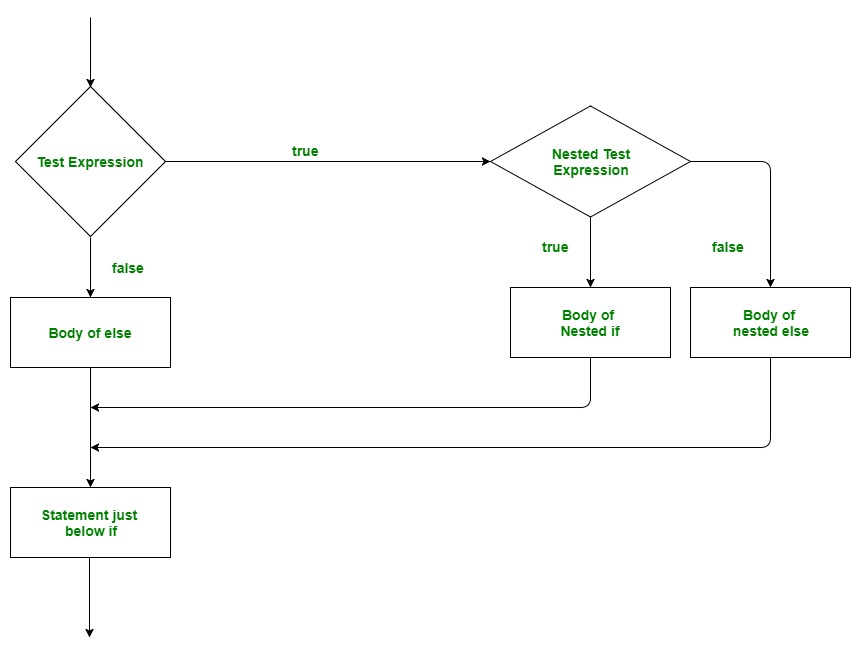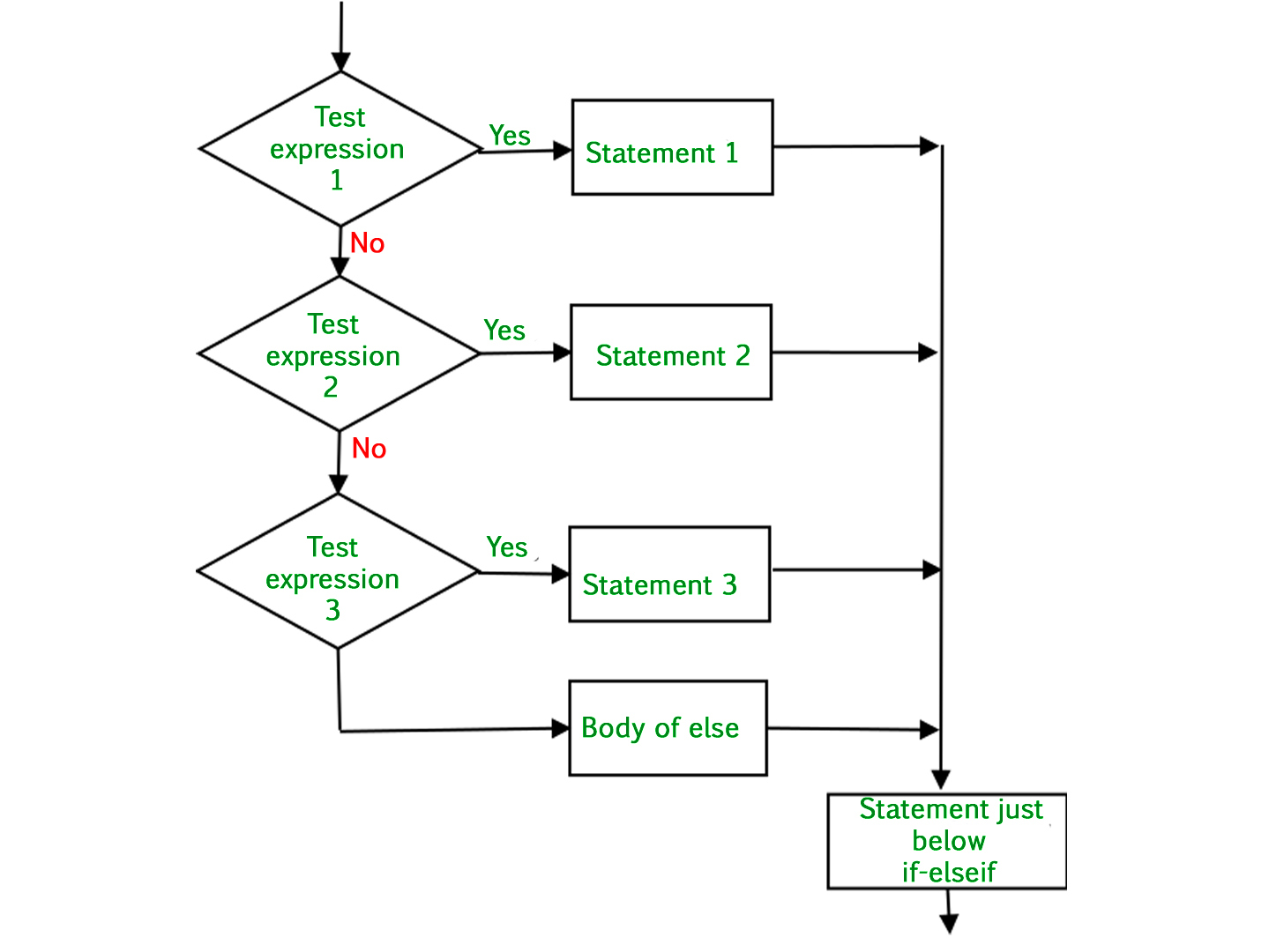In both real life and programming, decision-making is crucial. We often face situations where we need to make choices, and based on those choices, we determine our next actions. Similarly, in programming, we encounter scenarios where we must make decisions to control the flow of our code.
Conditional statements in Python play a key role in determining the direction of program execution. Among these, If-Else statements are fundamental, providing a way to execute different blocks of code based on specific conditions. As the name suggests, If-Else statements offer two paths, allowing for different outcomes depending on the condition evaluated.
Types of Control Flow in Python
Python If Statement
The if statement is the most simple decision-making statement. It is used to decide whether a certain statement or block of statements will be executed or not.
Flowchart of If Statement
Let's look at the flow of code in the Python If statements.

Flowchart of Python if statement
Syntax of If Statement in Python
Here, the condition after evaluation will be either true or false. if the statement accepts boolean values – if the value is true then it will execute the block of statements below it otherwise not.
#if syntax Python if condition: # Statements to execute if # condition is true
As we know, Python uses indentation to identify a block. So the block under the Python if statements will be identified as shown in the below example:
if condition:
statement1
statement2
# Here if the condition is true, if block
# will consider only statement1 to be inside
# its block.Example of Python if Statement
As the condition present in the if statements in Python is false. So, the block below the if statement is executed.
# python program to illustrate If statement
i = 10
if (i > 15):
print("10 is less than 15")
print("I am Not in if")
Output:
I am Not in ifPython If Else Statement
The if statement alone tells us that if a condition is true it will execute a block of statements and if the condition is false it won’t. But if we want to do something else if the condition is false, we can use the else statement with the if statement Python to execute a block of code when the Python if condition is false.
Flowchart of If Else Statement
Let's look at the flow of code in an if else Python statement.

Syntax of If Else in Python
if (condition):
# Executes this block if
# condition is true
else:
# Executes this block if
# condition is falseExample of Python If Else Statement
The block of code following the else if in Python, the statement is executed as the condition present in the if statement is false after calling the statement which is not in the block(without spaces).
# python program to illustrate else if in Python statement
#!/usr/bin/python
i = 20
if (i < 15):
print("i is smaller than 15")
print("i'm in if Block")
else:
print("i is greater than 15")
print("i'm in else Block")
print("i'm not in if and not in else Block")
Output:
i is greater than 15
i'm in else Block
i'm not in if and not in else BlockIf Else in Python using List Comprehension
In this example, we are using an Python else if statement in a list comprehension with the condition that if the element of the list is odd then its digit sum will be stored else not.
# Explicit function
def digitSum(n):
dsum = 0
for ele in str(n):
dsum += int(ele)
return dsum
# Initializing list
List = [367, 111, 562, 945, 6726, 873]
# Using the function on odd elements of the list
newList = [digitSum(i) for i in List if i & 1]
# Displaying new list
print(newList)
Output :
[16, 3, 18, 18]Python Nested If Statement
A nested if is an if statement that is the target of another if statement. Nested if statements mean an if statement inside another if statement.
Yes, Python allows us to nest if statements within if statements. i.e., we can place an if statement inside another if statement.
Flowchart of Python Nested if Statement

Flowchart of Python Nested if statement
Syntax:
if (condition1):
# Executes when condition1 is true
if (condition2):
# Executes when condition2 is true
# if Block is end here
# if Block is end hereExample of Python Nested If Statement
In this example, we are showing nested if conditions in the code, All the If condition in Python will be executed one by one.
# python program to illustrate nested If statement
i = 10
if (i == 10):
# First if statement
if (i < 15):
print("i is smaller than 15")
# Nested - if statement
# Will only be executed if statement above
# it is true
if (i < 12):
print("i is smaller than 12 too")
else:
print("i is greater than 15")
Output:
i is smaller than 15
i is smaller than 12 tooPython Elif
Here, a user can decide among multiple options. The if statements are executed from the top down.
As soon as one of the conditions controlling the if is true, the statement associated with that if is executed, and the rest of the ladder is bypassed. If none of the conditions is true, then the final "else" statement will be executed.
Flowchart of Elif Statement in Python
Let's look at the flow of control in if-elif-else ladder:

Flowchart of if-elif-else ladder
Syntax:
if (condition):
statement
elif (condition):
statement
.
.
else:
statement
Example of Python if-elif-else ladder
In the example, we are showing single if in Python, multiple elif conditions, and single else condition.
# Python program to illustrate if-elif-else ladder
#!/usr/bin/python
i = 20
if (i == 10):
print("i is 10")
elif (i == 15):
print("i is 15")
elif (i == 20):
print("i is 20")
else:
print("i is not present")
Output:
i is 20Ternary Statement | Short Hand If Else Statement
Whenever there is only a single statement to be executed inside the if block then shorthand if can be used. The statement can be put on the same line as the if statement.
Example of Python If shorthand
In the given example, we have a condition that if the number is less than 15, then further code will be executed.
if condition: statement# Python program to illustrate short hand if
i = 10
if i < 15: print("i is less than 15")
Output
i is less than 15Example of Short Hand If Else Statements
This can be used to write the if-else statements in a single line where only one statement is needed in both the if and else blocks.
Syntax: statement_when_True if condition else statement_when_False
In the given example, we are printing True if the number is 15, or else it will print False.
# Python program to illustrate short hand if-else
i = 10
print(True) if i < 15 else print(False)
Output:
TrueSimilar Reads:
- Python3 - if , if..else, Nested if, if-elif statements
- Using Else Conditional Statement With For loop in Python
- How to use if, else & elif in Python Lambda Functions